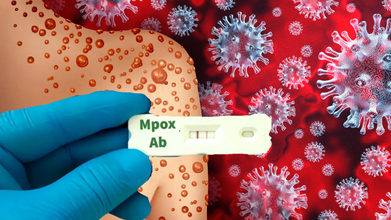- Health Conditions A-Z
- Health & Wellness
- Nutrition
- Fitness
- Health News
- Ayurveda
- Videos
- Medicine A-Z
- Parenting
Walking Dead Actress Kelley Mack Dies At 33 After Battling Glioma

Credits: Instagram
Walking Dead famed actress Kelley Mack has passed away at the age of 33 on Saturday at her birthplace of Cincinnati. Her demise was confirmed by a social media post by her sister, who mentioned, "It is with indelible sadness that we are announcing the passing of our dear Kelley. Such a bright, fervent light has transitioned to the beyond, where we all eventually must go."
As per Deadline, the actress was battling with glioma of the central nervous system. She had also posted her health update battling the same, and shared how her radiation therapy had been going.
What Is Glioma?
As per the Johns Hopkins Medicine, glioma is a common type of tumor originating in the brain. About 33% of all brain tumors are gliomas, which originate n the glial cells that surround and support neurons in the brains, including astrocytes, oligodendrocytes and ependymal cells.
Gliomas are called intra-axial brain tumors because they grow within the substance of the brain and often mix with normal brain tissue.
Types Of Glioma
Astrocytomas: Astrocytomas are tumors that form in glial cells, specifically from connective tissue cells called astrocytes. They are the most common type of primary intra-axial brain tumor, making up almost half of all primary brain tumors. These tumors are most often found in the cerebrum, the large outer part of the brain, but they can also occur in the cerebellum, located at the base of the brain.
Astrocytomas can affect both children and adults. In children, low-grade astrocytomas, known as pilocytic astrocytomas, are typically found in the cerebellum. In adults, these tumors are more commonly located in the cerebrum. The most aggressive form of astrocytoma is glioblastoma multiforme, a high-grade tumor that is considered the most malignant of all brain tumors. Its symptoms are often similar to those seen with other types of gliomas.
Brain stem gliomas: Brain stem gliomas, also known as diffuse infiltrating brainstem gliomas or DIPGs, are rare and usually found in the brain stem. Due to their location and the way they grow by blending into normal brain tissue, they are generally not removable by surgery. These tumors most often affect school-age children and are responsible for the highest number of childhood deaths from primary brain tumors.
Ependymomas: Ependymomas develop from ependymal cells, which line the brain’s ventricles or the spinal cord. Although they are rare, making up just 2 to 3 percent of primary brain tumors, they account for 8 to 10 percent of brain tumors in children, especially those younger than 10. In children, these tumors are usually found near the cerebellum, where they may block the flow of cerebrospinal fluid and lead to increased pressure in the skull. Ependymomas can also spread to other areas of the brain or spinal cord through spinal fluid, a process known as drop metastasis.
Mixed gliomas: Mixed gliomas, also called oligoastrocytomas, contain more than one type of glial cell. There is some debate over whether these tumors should be classified as a separate type, and genetic testing of tumor tissue is often used to clarify the diagnosis. These tumors usually occur in the cerebrum and are most common in adult men.
Oligodendrogliomas : Oligodendrogliomas form from oligodendrocytes, the supportive cells in the brain, and are usually located in the cerebrum. They make up about 2 to 4 percent of primary brain tumors and are more common in men, especially those in young to middle adulthood. Seizures are a frequent symptom, affecting up to 80 percent of patients, along with headaches, weakness, or speech problems. Oligodendrogliomas tend to have a better prognosis than many other gliomas.
Optic pathway gliomas: Optic pathway gliomas are low-grade tumors found in the optic nerve or optic chiasm. These tumors often affect people with neurofibromatosis and can lead to vision loss and hormone-related problems, especially since they tend to grow at the base of the brain, near areas responsible for hormone control. When these tumors impact hormone function, they may be referred to as hypothalamic gliomas.
What Are The Symptoms of Glioma?
- Headaches
- Seizures
- Personality changes
- Weakness in the arms, face or legs
- Numbness
- Problems with speech
- Nausea and vomiting
- Vision loss
- Dizziness
Not Delhi, But Ghaziabad Ranks As The Most Polluted City In India; Doctors Warn Of Health Emergency

While Delhi again woke up to a thick layer of haze on Tuesday, December 9, with the AQI remaining in "poor" and "very poor" categories as per the Air Quality Early Warning System for Delhi. A new Centre for Research on Energy and Clean Air (CREA) report released on December 6 noted that it is not Delhi, but Ghaziabad, which is the most polluted city in India, as of November 2025.
What Makes Ghaziabad The Most Polluted City In India?
Ghaziabad remained most polluted city in India, with a monthly average of PM2.5 or particulate matter 2.5 at the concentration of 224 µg/m³. This means Ghaziabad violated the National Ambient Air Quality Standards (NAAQS) on every day of the month as per the CREA's Monthly Air Quality Snapshot.
Of the entire month, the city experienced 19 "very poor" days, with 10 "severe" days and 1 "poor" day. In the list of top 10, Noida, Bahadurgarh, Delhi, Hapur, Greater Noida, Baghpat, Sonipat, Meerut and Rohtak also joined the list.
Of the 10 cities, six of them were from Uttar Pradesh, followed by 3 cities from Haryana and then Delhi. All cities except Delhi recorded PM2.5 levels higher than the previous year.
What About The Pollution Levels In Delhi?
The national capital ranked as the fourth most polluted city, recording a monthly average PM2.5 concentration of 215 µg/m³ in November, about twice its October level of 107 µg/m³. The city experienced 23 ʻVery Poorʼ days, six ʻSevereʼ days, and one ʻPoorʼ day throughout November.
Despite widespread pollution, the contribution of stubble burning was comparatively lower this year, an average of seven per cent in November, down from 20 per cent last year. Peak contributions of stubble burning reached 22 per cent, significantly lower than 38 per cent recorded in the previous year.
The analysis drew on real-time continuous ambient air quality monitoring stations (CAAQMS) PM2.5 data.
“Despite a significant reduction in stubble-burning influence, 20 out of 29 NCR cities recorded higher pollution levels than the previous year, and many still did not register a single day within NAAQS limits. This clearly indicates that the dominant drivers are year-round sources such as transport, industry, power plants, and other combustion sources. Without sector-specific emission cuts, cities will continue to breach standards,” said Manoj Kumar, analyst at CREA.
CREA's previous report has highlighted that Delhi’s air pollution almost doubled in November, with average PM2.5 levels touching 215 micrograms per cubic meter. The city recorded 23 days of very poor air, six severe days, and only one poor day. Although stubble burning played a smaller role this year, contributing an average of 7 percent, the pollution remained dangerously high.
Across India, pollution trends were equally worrying. Nine of the ten most polluted cities saw higher pollution levels than last year. Ghaziabad was the worst affected, with PM2.5 levels at 224 micrograms per cubic meter.
According to CREA analyst Manoj Kumar, declining stubble burning shows some progress, but major year round sources such as transport, industry, power plants, and other combustion activities continue to drive the crisis. Without strong emission cuts in these sectors, pollution levels will keep breaching national standards.
Doctors Warn of a Deepening Health Emergency
In an interview with ANI, doctors from AIIMS described Delhi’s air quality as a medical emergency. Prof Dr Anant Mohan and Dr Saurabh Mittal from the Department of Pulmonary, Critical Care, and Sleep Medicine said the current situation is now putting vulnerable groups at serious risk, including pregnant women, unborn babies, newborns, and adults with heart or neurological conditions.
Dr Mohan warned that the impacts may be felt for generations. Since the particles are extremely small, they can pass from a pregnant woman to the fetus and interfere with growth. Babies exposed to such conditions in the womb are more likely to be underweight and may have weaker lungs as they grow. Some complications might show up only later in life.
Dr Mittal added that the effects of toxic air go far beyond respiratory illness. Prolonged exposure is increasing cases of breathlessness, lung inflammation, asthma attacks, and chronic conditions like COPD. Fine particulate matter is also entering the bloodstream, raising the risk of heart attacks and strokes.
The growing health concerns underline the need for immediate and coordinated action, making the work of the newly formed expert group even more urgent.
How To Read Delhi's AQI?
- 0-50: 'good'
- 51-100: 'satisfactory'
- 101-200: 'moderate'
- 201-300: 'poor'
- 301-400: 'very poor'
- 401-500: 'severe'
New Mpox Strain Detected In England; It Is A Mix Of Clade Ib and Clade IIb, More Details Inside

Credits: iStock
A new strain of mpox or what was previous known as monkeypox has been detected in a person in England, confirmed the UK health officials. This strain is a mix of the two major type of mpox virus that was found in someone who had recently returned from travelling in Asia.
The officials have said that they are still assessing the significance of the new strain. As per the UK Health Security Agency (UKHSA), it is normal for viruses to evolve. The best shield of protection is to get vaccinated against such disease, even if the infector remain mild for most.
What Is The New Virus Strain Of Mpox?
The new virus strain contains elements from two mpox strain, which are clade Ib and clade IIb. The strain as of now has no name.
UK officials have also recently encouraged gay, bisexual and other men who have sex with men to get vaccinated against mpox. This call has come as the strain clade Ib showed early signs of local spread in some of the European countries. Whereas, the clade IIB is linked to a global outbreak of mpox in 2022 that affected countries across the globe.
Vaccines Available For Who?
In the UK, the vaccination is available for the most vulnerable group at the risk of catching mpox:
- those who have multiple sexual partners
- those who engage in group sex
- those who visit sex-on-premises venues
Health officials report that the mpox vaccine offers about 75 to 80 percent protection. Although there are no specific studies yet on how well the vaccine works against the newest strain, experts believe it should still provide a strong level of defense.
Dr. Katy Sinka, head of sexually transmitted infections at the UK Health Security Agency (UKHSA), told BBC that genomic testing made it possible to identify this strain. She explained that viruses naturally evolve and that ongoing analysis will help scientists understand how mpox is changing. Dr. Sinka encouraged eligible individuals to get vaccinated, calling it a proven way to prevent severe illness.
Global Readiness and Gaps in Access
Prof. Trudie Lang, director of the Global Health Network at the University of Oxford, told the BBC that the UK has strong systems to detect cases and stop further spread. However, she noted that this is much more difficult in other regions, particularly in vulnerable populations where vaccine access is limited.
According to Prof. Lang, if more cases of this strain begin to appear in the UK or internationally, researchers will need to closely track how the virus spreads and how sick it makes people. Understanding these patterns will help determine whether the new strain poses more or less risk than previous ones.
Rising Global Cases and Concerns
Nearly 48,000 mpox cases have been confirmed worldwide in 2025, including about 2,500 in the past month. Most infections have been reported in central Africa.
Dr. Boghuma Titanji, assistant professor of medicine at Emory University, said the emergence of a new strain is what experts expected as the virus continued to circulate globally. She warned that allowing ongoing transmission gives mpox more chances to adapt and embed itself as a long-term human pathogen.
What Is Mpox?
Mpox is a viral illness that can cause significant discomfort. Common symptoms include lesions or a rash lasting two to four weeks. People may also experience fever, headaches, back pain, muscle aches and fatigue.
The virus spreads through close physical contact, respiratory droplets from coughs or sneezes and shared items such as bedding, towels or clothing.
Health officials advise anyone who suspects they may have mpox to contact NHS 111 for guidance on next steps.
Health Emergency Looms As Delhi Forms Expert Panel To Fight Air Pollution

Credits: iStock
Coughs. Sneezing. Wheezing. All of this can be heard everywhere, with many people taking sick leaves, and coming back to office still with health complains. This is what is happening in Delhi as the national capital remains in the 'very poor' category for its Monday morning Air Quality Index (AQI). The average AQI of the city stood at 318 on 7am, as per the Central Pollution Control Board (CPCB). The thick layer of smog has engulfed the city and there has been no improvement to get rid of the toxic air. Visibility too has been reduced in several areas, including Anand Vihar, India Gate, Dwarka, and ITO.
Amid the continuously worsening air condition in Delhi, the government has now formed an 'expert group' to combat air pollution as health crisis rise.
The panel will study how pollution builds up from human activity as well as natural causes and will recommend technology upgrades, policy reforms, and sector specific interventions that can be put into action.
Who Will Lead the Expert Panel
The group will be chaired by retired IAS officer and former Union Environment Secretary Leena Nandan. Other members include former CPCB member secretary Dr JS Kamyotra, IIT Delhi professor emeritus Mukesh Khare, IIT Kanpur professor emeritus Mukesh Sharma, and Dr Suneel Pandey, director of Circular Economy and Waste Management at TERI. Representatives from CAQM, the IMD, APAG, PHDCCI and senior officials from the Delhi government are also part of the group. The Secretary of Environment and Forest is a member, and the DPCC chairman will serve as member secretary.
What the Group Will Do
This expert panel will act as a high level advisory body, offering clear, actionable guidance that can shape both emergency responses and long term reforms. It will track the progress of current pollution control programs, study global best practices, and flag where corrections are needed. The group will meet every month, either in person or virtually, and will receive administrative support from the Delhi Pollution Control Committee. The initial tenure is six months, with the option to extend if required.
Government Planning and Oversight
Chief Minister Rekha Gupta has approved the expert group, along with a separate High Level Implementation Committee chaired by the Chief Secretary. While the expert group will guide policy and strategy, the implementation committee is responsible for enforcing directives, coordinating across departments, and ensuring timely action. Delhi BJP leader Manjinder Singh Sirsa has welcomed the move and said that combined efforts from the government and citizens can make a meaningful difference.
Delhi’s Pollution Levels Are Rising Fast
A new analysis by the Centre for Research on Energy and Clean Air (CREA) highlights the scale of the crisis. Delhi’s air pollution almost doubled in November, with average PM2.5 levels touching 215 micrograms per cubic meter. The city recorded 23 days of very poor air, six severe days, and only one poor day. Although stubble burning played a smaller role this year, contributing an average of 7 percent, the pollution remained dangerously high.
Across India, pollution trends were equally worrying. Nine of the ten most polluted cities saw higher pollution levels than last year. Ghaziabad was the worst affected, with PM2.5 levels at 224 micrograms per cubic meter.
According to CREA analyst Manoj Kumar, declining stubble burning shows some progress, but major year round sources such as transport, industry, power plants, and other combustion activities continue to drive the crisis. Without strong emission cuts in these sectors, pollution levels will keep breaching national standards.
Doctors Warn of a Deepening Health Emergency
In an interview with ANI, doctors from AIIMS described Delhi’s air quality as a medical emergency. Prof Dr Anant Mohan and Dr Saurabh Mittal from the Department of Pulmonary, Critical Care, and Sleep Medicine said the current situation is now putting vulnerable groups at serious risk, including pregnant women, unborn babies, newborns, and adults with heart or neurological conditions.
Dr Mohan warned that the impacts may be felt for generations. Since the particles are extremely small, they can pass from a pregnant woman to the fetus and interfere with growth. Babies exposed to such conditions in the womb are more likely to be underweight and may have weaker lungs as they grow. Some complications might show up only later in life.
Dr Mittal added that the effects of toxic air go far beyond respiratory illness. Prolonged exposure is increasing cases of breathlessness, lung inflammation, asthma attacks, and chronic conditions like COPD. Fine particulate matter is also entering the bloodstream, raising the risk of heart attacks and strokes.
The growing health concerns underline the need for immediate and coordinated action, making the work of the newly formed expert group even more urgent.
How To Read Delhi's AQI?
0-50: 'good'
51-100: 'satisfactory'
101-200: 'moderate'
201-300: 'poor'
301-400: 'very poor'
401-500: 'severe'
© 2024 Bennett, Coleman & Company Limited

